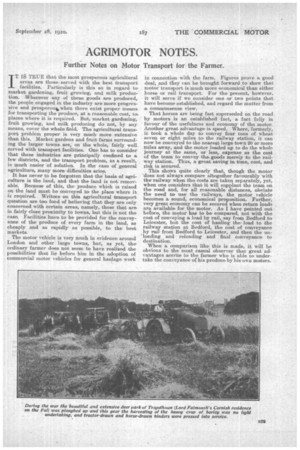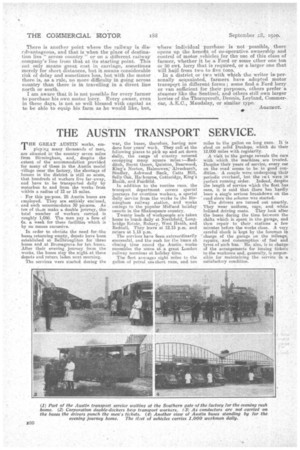AGRIMOTOR NOTES.
Page 35

Page 36

If you've noticed an error in this article please click here to report it so we can fix it.
Further Notes on Motor Transport for the Farmer.
IT 18 TRUE that the most prosperous agricultural areas are thoseserved with the best transport facilities. Particularly is this so in regard to market gardening, fruit growing, and milk production. Wherever any of these goods are produced, the people engaged in the industry are more progressive and prosperous when there exist proper means for transporting the produce, at a reasonable cost, to; places where it is required. But, market gardening, fruit growing, and milk producing do not, by any means, cover the whole field. The agricultural transport problem proper is very much more extensive than this. Market gardens and fruit farms surrounding the larger towns are, on the whole, fairly well served with transport facilities. One has to consider that these industries are principally confined to a few districts, and the transport problem, as a result, is much easier of solution. In the case of general agriculture, many more difficulties arise.
It has never to be forgotten that the basis of agriculture is the land, and that the land is not removable. Because of this, the produce which is raised • on the land must be conveyed to the place where it is required. Writers on this agricultural transport question are too fond of believing that they are only concerned with certain areas, namely, those that are in fairly close proximity to towns, but this is not the case. Facilities have to be provided for the conveyance of the produce of every farm in the land, as cheaply and as rapidly as possible, to the best markets.
The motor vehicle is very much in evidence around London and other large towns, but, as yet, the ordinary farmer does not seem to have realized the possibilities that lie before him. in the adoption of commercial motor vehicles for general haulage work in connection with the farm. Figures prove a good deal, and they can be brought forward to show that motor transport is much more economical than either horse or rail transport. For the present, however, it will serve if we consider one or two points that have become established, and regard the matter from commonsense view.
That horses are being fast superseded on the road by motors is an established fact, a fact fully in • favour of the usefulness and economy of the motor. Another great advantage is speed. Where, formerly, it took a whole day to convey four tons of wheat seven or eight miles to the railway station, it can now be conveyed to the nearest large town 20 or more miles away, and the motor loaded up to-do the whole journey at the same, or less, expense as the cost of the team to convey the goods merely to the railway station. Thus, a great saving in. time, cost, and risk is secured.
This shows quite clearly that, though the. motor -does not always compare altogether favourably with the.railway when the costa aretaken separately, yet; when one considersthat it will supplant the team on the road and, for all reasonable distances, obviate the need to use the railways, the motor vehicle becomes a sound, economical proposition. Further, very great economy can be secured when return loads are available for the.motor. As I have pointed out before, the motor has to be compared, not with the cost of conveying a load by rail, say from Bedford to Leicester, but the cost of hauling the, load to the railway station at Bedford, the cost of conveyance by rail from Bedford to Leicester, and then the unloading and reloading and final conveyance to destination.
When a comparison like this is made, it will be obvious to the most casual observer that great advantages accrue to the farmer who is able to undertake the conveyance of his produce by hisown motors. There is another point where the railway is clis= ndvantageous, and that is when the place of destination lies " across country " or on a different railway company's line from that at its starting point. This not only means great cost in carriage, sometimes merely fen' short distances, but it means considerable risk of delay and sometimes loss, but with the motor there is, as a rule, no more difficulty in going across country than there is in travelling in a direct line north or south.
I am aware that it is not possible for every farmer to purchase his own motor lorry. Every owner, even in these days, is not so well blessed with capital as to be able to equip his farm as he would like, but, where individual purchase is not possible,, there opens up the benefit or co-operative. ownership and control of motor vehicles for the use of this class of farmer, whether it be a Ford or some other one ton or 30 cwt. lorry that is required, or a larger one that will hatil,from two to five tans. .
In a 'district or two with which the writer is. personally acquainted, farmers have adopted motor transport in different forms ; some find. a Ford lorry or van sufficient for their purposes, others prefer a steamer like the Sentinel, and others still awn larger lorries of the Thornycroft, Dennis, Leyland, CommerCar, A.E.C., Maudslay, or similar type.
AGEIMOT.






































